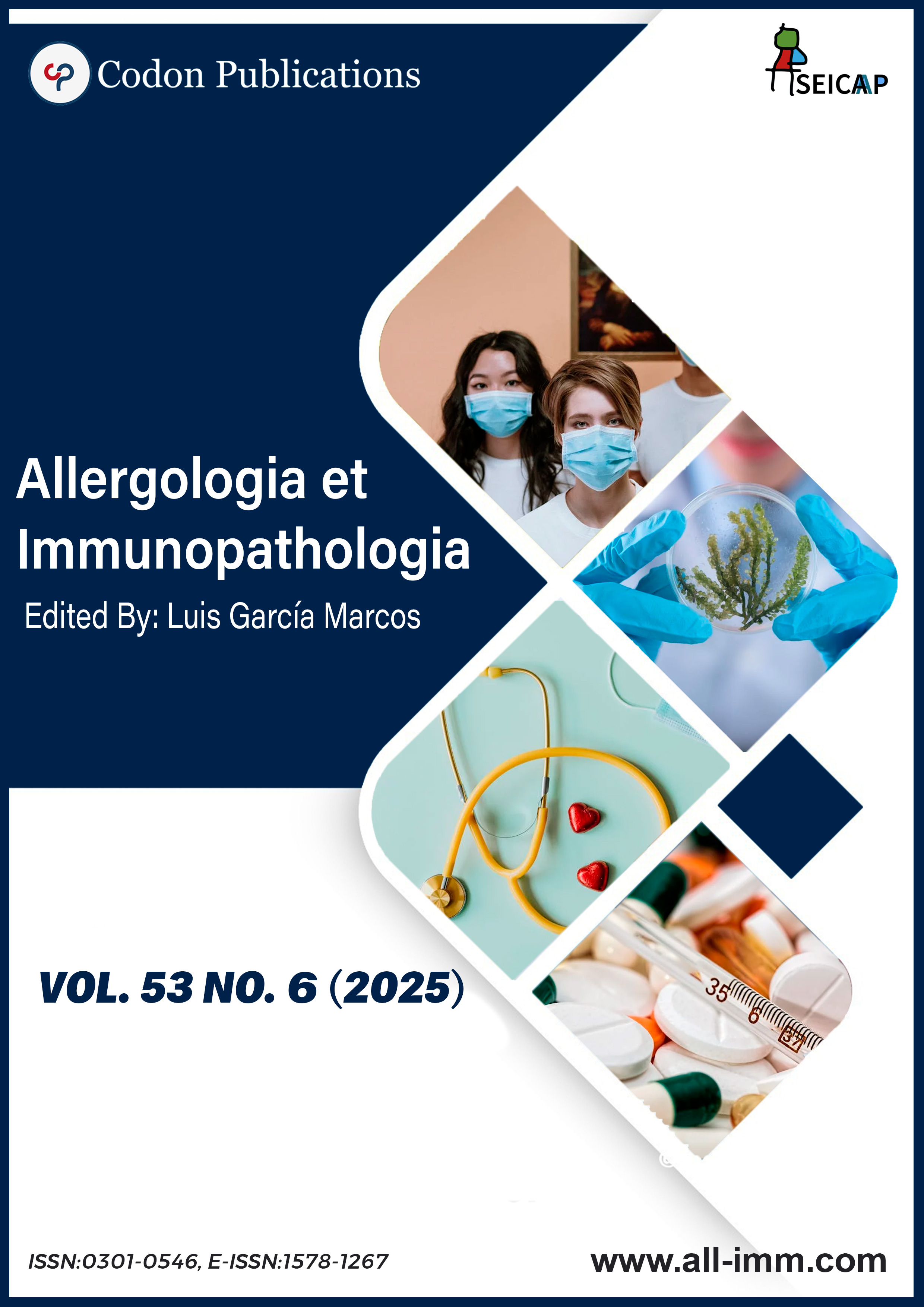Insights into the clinical spectrum of selective IgA deficiency: Data from two centers
Main Article Content
Keywords
allergic diseases, autoimmune disease, immunoglobulin a deficiency, immunoglobulin subclasses, primary immunodeficiency diseases
Abstract
Introduction: Selective IgA deficiency (sIgAD) is the most common primary immunodeficiency, yet its clinical presentation ranges from asymptomatic cases to individuals suffering from recurrent infections, allergic manifestations, and autoimmune disorders. Limited data exist regarding the immunological and clinical profiles of pediatric patients with sIgAD in Türkiye.
Methods: We conducted a retrospective analysis of 45 pediatric patients (20 females and 25 males) diagnosed with sIgAD and followed at two tertiary care centers. Demographic features, allergic and autoimmune comorbidities, and immunological parameters were evaluated. Lymphocyte subset analyses and immunoglobulin subclass levels were recorded. Associations between IgG3/IgG4 subclass deficiencies and infection frequency were assessed using the Mann–Whitney U test.
Results: The median current age was 102 months (range: 48–204), with a median age of symptom onset at 24 months (range: 1–186), referral at 88 months (range: 6–199), and diagnosis at 87 months (range: 48–192). A history of at least one allergic disease, including asthma, allergic rhinitis, and/or atopic dermatitis, was present in 66.7% of patients. Autoimmune conditions were identified in 13.3%, including Hashimoto’s thyroiditis, vitiligo, and immune thrombocytopenic purpura. No statistically significant differences in the frequencies of upper respiratory tract infections, pneumonia, otitis, or viral infections were observed between patients with low versus normal/high IgG3 or IgG4 levels (all P > 0.05).
Conclusion: Our findings highlight the high prevalence of allergic diseases and the clinical heterogeneity of sIgAD in children. Moreover, isolated IgG3 or IgG4 subclass deficiencies may not independently influence infection susceptibility. Longitudinal studies are warranted to better define the prognostic role of immunoglobulin subclasses in pediatric sIgAD.
References
2 Yazdani R, Latif A, Tabassomi F, Abolhassani H, Azizi G, Rezaei N, et al. Clinical phenotype classification for selective immunoglobulin A deficiency. Expert Rev Clin Immunol. 2015;11(11):1245–54. 10.1586/1744666X.2015.1081565
3 Janzi M, Kull I, Sjoberg R, Wan J, Melen E, Bayat N, et al. Selective IgA deficiency in early life: Association to infections and allergic diseases during childhood. Clin Immunol. 2009;133(1):78–85. 10.1016/j.clim.2009.05.014
4 Aghamohammadi A, Cheraghi T, Gharagozlou M, Movahedi M, Rezaei N, Yeganeh M, et al. IgA deficiency: Correlation between clinical and immunological phenotypes. J Clin Immunol. 2009;29(1):130–6. 10.1007/s10875-008-9229-9
5 Jorgensen GH, Gardulf A, Sigurdsson MI, Sigurdardottir ST, Thorsteinsdottir I, Gudmundsson S, et al. Clinical symptoms in adults with selective IgA deficiency: A case-control study. J Clin Immunol. 2013;33(4):742–7. 10.1007/s10875-012-9858-x
6 Yazdani R, Azizi G, Abolhassani H, Aghamohammadi A. Selective IgA deficiency: Epidemiology, pathogenesis, clinical phenotype, diagnosis, prognosis and management. Scand J Immunol. 2017;85(1):3–12. 10.1111/sji.12499
7 Conley ME. Diagnostic guidelines—An International Consensus document. Clin Immunol. 1999;93(3):189. 10.1006/clim.1999.4798
8 Besci O, Baser D, Ogulur I, Berberoglu AC, Kiykim A, Besci T, et al. Reference values for T and B lymphocyte subpopulations in Turkish children and adults. Turk J Med Sci. 2021;51(4):1814–24. 10.3906/sag-2010-176
9 Berkel AI, Tezcan I, Ersoy F, Sanal O. Serum immunoglobulin G subclass values in healthy Turkish children and adults. Turk J Pediatr. 1994;36(3):197–204.
10 Subbarayan A, Colarusso G, Hughes SM, Gennery AR, Slatter M, Cant AJ, et al. Clinical features that identify children with primary immunodeficiency diseases. Pediatrics. 2011;127(5):810–6. 10.1542/peds.2010-3680
11 Basturk B, Sari S, Aral A, Dalgic B. Prevalence of selective immunoglobulin A deficiency in healthy Turkish school children. Turk J Pediatr. 2011;53(4):364–8.
12 Aytekin C, Tuygun N, Gokce S, Dogu F, Ikinciogullari A. Selective IgA deficiency: Clinical and laboratory features of 118 children in Turkey. J Clin Immunol. 2012;32(5):961–6. 10.1007/s10875-012-9702-3
13 Morawska I, Kurkowska S, Bebnowska D, Hrynkiewicz R, Becht R, Michalski A, et al. The Epidemiology and Clinical Presentations of Atopic Diseases in Selective IgA Deficiency. J Clin Med. 2021;10(17):3809. 10.3390/jcm10173809
14 Shkalim V, Monselize Y, Segal N, Zan-Bar I, Hoffer V, Garty BZ. Selective IgA deficiency in children in Israel. J Clin Immunol. 2010;30(5):761–5. 10.1007/s10875-010-9438-x
15 Ammann AJ, Hong R. Selective IgA deficiency and autoimmunity. Clin Exp Immunol. 1970;7(6):833–8.
16 Buckley RH. Clinical and immunologic features of selective IgA deficiency. Birth Defects Orig Artic Ser. 1975;11(1):134–42.
17 Edwards E, Razvi S, Cunningham-Rundles C. IgA deficiency: Clinical correlates and responses to pneumococcal vaccine. Clin Immunol. 2004;111(1):93–7. 10.1016/j.clim.2003.12.005
18 Erkocoglu M, Metin A, Kaya A, Ozcan C, Akan A, Civelek E, et al. Allergic and autoimmune disorders in families with selective IgA deficiency. Turk J Med Sci. 2017;47(2):592–8. 10.3906/sag-1605-50
19 Civelek E, Cakir B, Boz AB, Yuksel H, Orhan F, Uner A, et al. Extent and burden of allergic diseases in elementary schoolchildren: A national multicenter study. J Investig Allergol Clin Immunol. 2010;20(4):280–8.
20 Cooper GS, Stroehla BC. The epidemiology of autoimmune diseases. Autoimmun Rev. 2003;2(3):119–25. 10.1016/s1568-9972(03)00006-5
21 Eaton WW, Rose NR, Kalaydjian A, Pedersen MG, Mortensen PB. Epidemiology of autoimmune diseases in Denmark. J Autoimmun. 2007;29(1):1–9. 10.1016/j.jaut.2007.05.002
22 Jorgensen GH, Thorsteinsdottir I, Gudmundsson S, Hammarstrom L, Ludviksson BR. Familial aggregation of IgAD and autoimmunity. Clin Immunol. 2009;131(2):233–9. 10.1016/j.clim.2008.11.013
23 Jacob CM, Pastorino AC, Fahl K, Carneiro-Sampaio M, Monteiro RC. Autoimmunity in IgA deficiency: Revisiting the role of IgA as a silent housekeeper. J Clin Immunol. 2008;28 Suppl 1:S56–61. 10.1007/s10875-007-9163-2
24 Parker AR, Skold M, Ramsden DB, Ocejo-Vinyals JG, Lopez-Hoyos M, Harding S. The clinical utility of measuring IgG subclass immunoglobulins during immunological investigation for suspected primary antibody deficiencies. Lab Med. 2017;48(4):314–25. 10.1093/labmed/lmx058
25 Ludwig-Kraus B, Kraus FB. Similar but not consistent: Revisiting the pitfalls of measuring IgG subclasses with different assays. J Clin Lab Anal. 2017;31(6):e22146. 10.1002/jcla.22146
26 Heiner DC. IgG subclass deficiencies: Identifying and treating patients at risk. Vox Sang. 1986;51 Suppl 2:57–62. 10.1111/j.1423-0410.1986.tb02009.x

